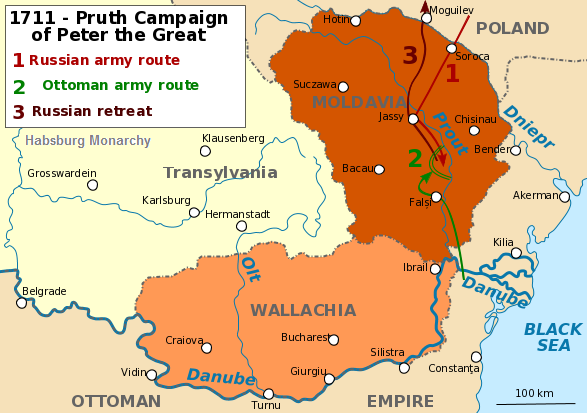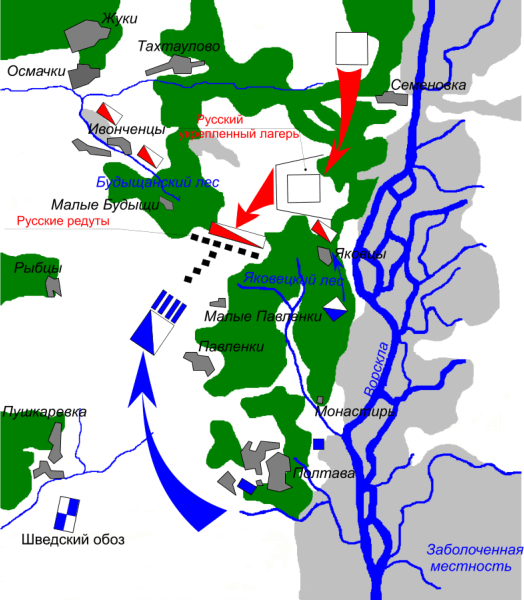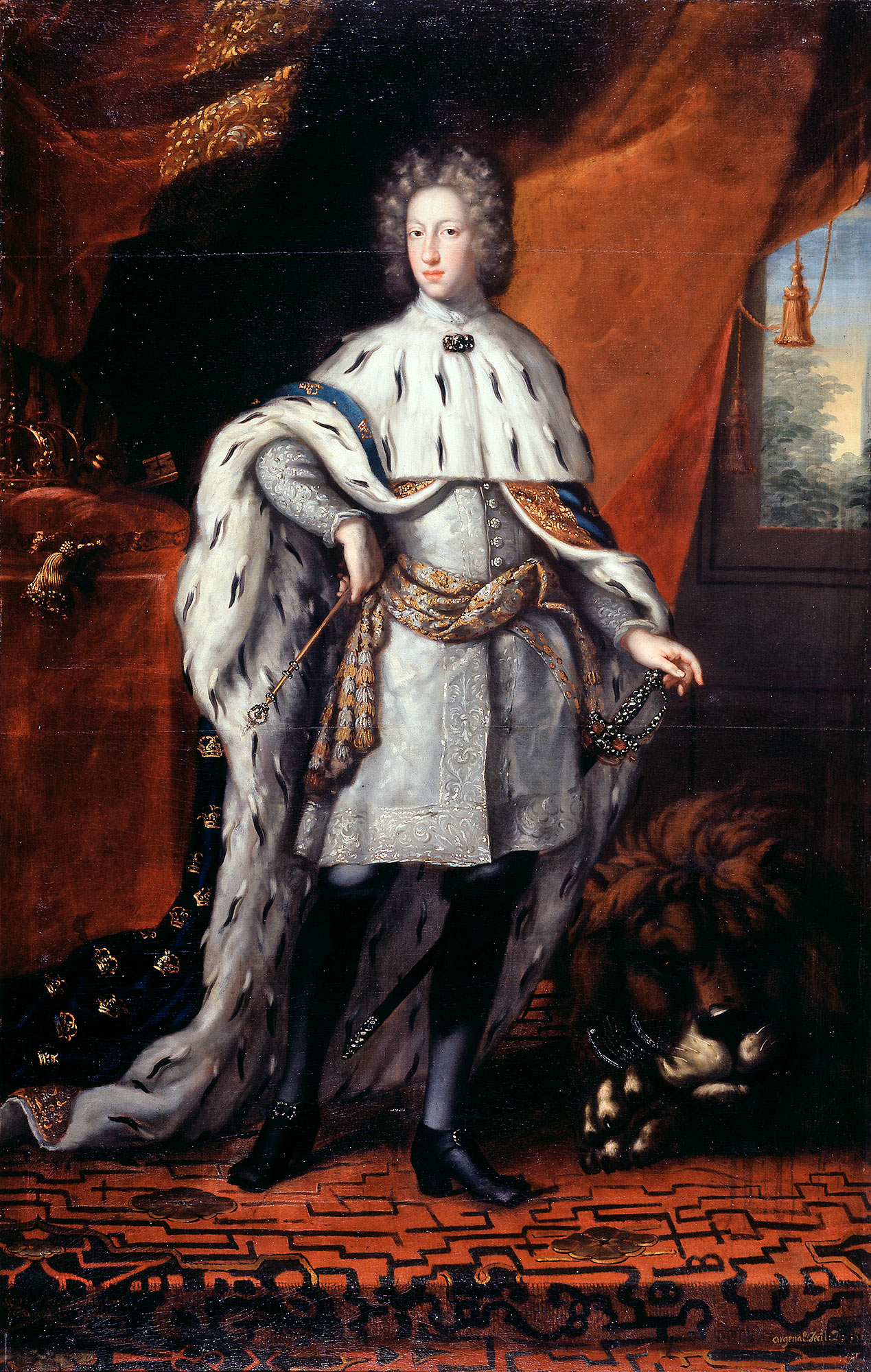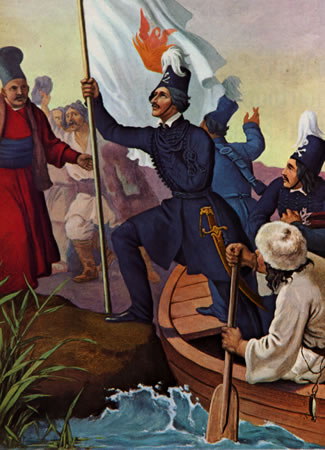|
Russo-Turkish War (1710–1711)
The Russo-Ottoman War of 1710—1711, also known as the Pruth River Campaign, was a brief military conflict between the Tsardom of Russia and the Ottoman Empire. The main battle took place during 18-22 July 1711 in the basin of the Pruth river near Stănilești (Stanilesti) after Tsar Peter I entered the Ottoman vassal Principality of Moldavia, following the Ottoman Empire’s declaration of war on Russia. The ill-prepared 38,000 Russians with 5,000 Moldavians, found themselves surrounded by 200,000 Turks under Grand Vizier Baltaci Mehmet Pasha. After three days of fighting and heavy casualties the Tsar and his armies were allowed to withdraw after agreeing to abandon the fortress of Azov and its surrounding territory. The Ottoman victory led to the Treaty of the Pruth which was confirmed by the Treaty of Adrianople. Background The Russo-Ottoman War of 1710-1711 broke out as a result of the Great Northern War, which pitted the Swedish Empire of King Charles XII of Sweden ag ... [...More Info...] [...Related Items...] OR: [Wikipedia] [Google] [Baidu] |
Great Northern War
The Great Northern War (1700–1721) was a conflict in which a coalition led by the Tsardom of Russia successfully contested the supremacy of the Swedish Empire in Northern, Central and Eastern Europe. The initial leaders of the anti-Swedish alliance were Peter I of Russia, Frederick IV of Denmark–Norway and Augustus II the Strong of Saxony– Poland–Lithuania. Frederick IV and Augustus II were defeated by Sweden, under Charles XII, and forced out of the alliance in 1700 and 1706 respectively, but rejoined it in 1709 after the defeat of Charles XII at the Battle of Poltava. George I of Great Britain and the Electorate of Hanover joined the coalition in 1714 for Hanover and in 1717 for Britain, and Frederick William I of Brandenburg-Prussia joined it in 1715. Charles XII led the Swedish army. Swedish allies included Holstein-Gottorp, several Polish magnates under Stanislaus I Leszczyński (1704–1710) and Cossacks under the Ukrainian Hetman Ivan Mazepa (1708 ... [...More Info...] [...Related Items...] OR: [Wikipedia] [Google] [Baidu] |
Baltacı Mehmet Pasha
Baltacı Mehmet Pasha (also called Pakçemüezzin Baltacı Mehmet Pasha, sometimes known just as Baltacı or Baltadji; 1662, Osmancık – July 1712, Lemnos) was an Ottoman statesman who served as grand vizier of the Ottoman Empire, first from 1704 to 1706 and again in 1710 to 1711, and as Kapudan Pasha (grand admiral of the Ottoman Navy) in 1704. Early years Mehmet was born in Osmancık, near Çorum (modern Turkey). He was of Turkish origin. He travelled to North Africa, which was then Ottoman territory. He then came to Constantinople, the capital of the empire, where he found a job as a baltacı (palace employee) in the palace of the sultan which earned him the epithet ''Baltacı''. He also worked as a secretary and muezzin (person who calls others to prayer in Islamic tradition) and earned the nickname ''pakçemuezzin''. Soon, he was promoted to be the chief stableman (''imrahor'') and then Grand Admiral (Kapudan Pasha) in 1704. On 25 December 1704, he became the grand ... [...More Info...] [...Related Items...] OR: [Wikipedia] [Google] [Baidu] |
Bender, Moldova
Bender (, Moldovan Cyrillic: Бендер) or Bendery (russian: Бендеры, , uk, Бендери), also known as Tighina ( ro, Tighina), is a city within the internationally recognized borders of Moldova under ''de facto'' control of the unrecognized Pridnestrovian Moldavian Republic (Transnistria) (PMR) since 1992. It is located on the western bank of the river Dniester in the Romanian historical region of Bessarabia. Together with its suburb Proteagailovca, the city forms a municipality, which is separate from Transnistria (as an administrative unit of Moldova) according to Moldovan law. Bender is located in the buffer zone established at the end of the 1992 War of Transnistria. While the Joint Control Commission has overriding powers in the city, Transnistria has ''de facto'' administrative control. The fortress of Tighina was one of the important historic fortresses of the Principality of Moldova until 1812. Name First mentioned in 1408 as ''Tyagyanyakyacha'' ... [...More Info...] [...Related Items...] OR: [Wikipedia] [Google] [Baidu] |
Battle Of Poltava
The Battle of Poltava; russian: Полта́вская би́тва; uk, Полта́вська би́тва (8 July 1709) was the decisive and largest battle of the Great Northern War. A Russian army under the command of Tsar Peter I defeated a Swedish army, under the command of Carl Gustaf Rehnskiöld. The battle put an end to the status of the Swedish Empire as a European great power, as well as its eastbound expansion, and marked the beginning of Russian hegemony in Northern Europe. During the course of six years in the initial stages of the war, King Charles XII and the Swedish Empire had defeated almost all participants in the anti-Swedish coalition, which initially consisted of the Polish-Lithuanian Commonwealth, Denmark-Norway and the Tsardom of Russia. The latter under Tsar Peter I's rule was the only one still undefeated. Charles XII therefore chose to invade Russia in the autumn of 1707 and march towards Moscow with a large Swedish army. However, the campaign ... [...More Info...] [...Related Items...] OR: [Wikipedia] [Google] [Baidu] |
Russian Empire
The Russian Empire was an empire and the final period of the List of Russian monarchs, Russian monarchy from 1721 to 1917, ruling across large parts of Eurasia. It succeeded the Tsardom of Russia following the Treaty of Nystad, which ended the Great Northern War. The rise of the Russian Empire coincided with the decline of neighbouring rival powers: the Swedish Empire, the Polish–Lithuanian Commonwealth, Qajar Iran, the Ottoman Empire, and Qing dynasty, Qing China. It also held colonies in North America between 1799 and 1867. Covering an area of approximately , it remains the list of largest empires, third-largest empire in history, surpassed only by the British Empire and the Mongol Empire; it ruled over a population of 125.6 million people per the Russian Empire Census, 1897 Russian census, which was the only census carried out during the entire imperial period. Owing to its geographic extent across three continents at its peak, it featured great ethnic, linguistic, re ... [...More Info...] [...Related Items...] OR: [Wikipedia] [Google] [Baidu] |
Charles XII Of Sweden
Charles XII, sometimes Carl XII ( sv, Karl XII) or Carolus Rex (17 June 1682 – 30 November 1718 O.S.), was King of Sweden (including current Finland) from 1697 to 1718. He belonged to the House of Palatinate-Zweibrücken, a branch line of the House of Wittelsbach. Charles was the only surviving son of Charles XI and Ulrika Eleonora the Elder. He assumed power, after a seven-month caretaker government, at the age of fifteen. In 1700, a triple alliance of Denmark–Norway, Saxony– Poland–Lithuania and Russia launched a threefold attack on the Swedish protectorate of Holstein-Gottorp and provinces of Livonia and Ingria, aiming to draw advantage as the Swedish Empire was unaligned and ruled by a young and inexperienced king, thus initiating the Great Northern War. Leading the Swedish army against the alliance, Charles won multiple victories despite being usually significantly outnumbered. A major victory over a Russian army some three times the size in 1700, at the ... [...More Info...] [...Related Items...] OR: [Wikipedia] [Google] [Baidu] |
Treaty Of The Pruth
The Treaty of the Pruth was signed on the banks of the river Prut between the Ottoman Empire and the Tsardom of Russia on 23 July 1711 ending the Russo-Turkish War of 1710–1711. The treaty was a political victory for the Ottoman Empire. The Treaty stipulated the return of Azov Fortress to the Ottomans, Taganrog and several Russian fortresses were to be demolished, and the Tsar pledged to stop interfering in the affairs of the Polish–Lithuanian Commonwealth, which the Russians increasingly saw as under their sphere of influence. Background The indirect causes of the war can be attributed to the aggressive expansion of the Swedish Empire throughout the 16th and 17th centuries. Sweden’s aggressive expansion in Scandinavia forced a coalition of Eastern European nations to form and contain them, including the Tsardom of Russia. After defeat at the Battle of Narva in 1700, Russia was invaded by King Charles XII as part of the Great Northern War. The invasion of Russia was ... [...More Info...] [...Related Items...] OR: [Wikipedia] [Google] [Baidu] |
Azov
Azov (russian: Азов), previously known as Azak, is a town in Rostov Oblast, Russia, situated on the Don River just from the Sea of Azov, which derives its name from the town. Population: History Early settlements in the vicinity The mouth of the Don River has always been an important commercial center. At the start of the 3rd century BCE, the Greeks from the Bosporan Kingdom founded a colony here, which they called '' Tanais'' (after the Greek name of the river). Several centuries later, in the last third of 1st century BCE, the settlement was burned down by king Polemon I of Pontus. The introduction of Greek colonists restored its prosperity, but the Goths practically annihilated it in the 3rd century. The site of ancient Tanais, now occupied by the '' khutor'' of Nedvigovka, has been excavated since the mid-19th century. In the 5th century, the area was populated by Karadach and his Akatziroi. They were ruled by Dengizich the Hun. Byzantium gave t ... [...More Info...] [...Related Items...] OR: [Wikipedia] [Google] [Baidu] |
Peter The Great
Peter I ( – ), most commonly known as Peter the Great,) or Pyotr Alekséyevich ( rus, Пётр Алексе́евич, p=ˈpʲɵtr ɐlʲɪˈksʲejɪvʲɪtɕ, , group=pron was a Russian monarch who ruled the Tsardom of Russia from to 1721 and subsequently the Russian Empire until his death in 1725, jointly ruling with his elder half-brother, Ivan V until 1696. He is primarily credited with the modernisation of the country, transforming it into a European power. Through a number of successful wars, he captured ports at Azov and the Baltic Sea, laying the groundwork for the Imperial Russian Navy, ending uncontested Swedish supremacy in the Baltic and beginning the Tsardom's expansion into a much larger empire that became a major European power. He led a cultural revolution that replaced some of the traditionalist and medieval social and political systems with ones that were modern, scientific, Westernised and based on the Enlightenment. Peter's reforms had a lastin ... [...More Info...] [...Related Items...] OR: [Wikipedia] [Google] [Baidu] |
Prut
The Prut (also spelled in English as Pruth; , uk, Прут) is a long river in Eastern Europe. It is a left tributary of the Danube. In part of its course it forms Romania's border with Moldova and Ukraine. Characteristics The Prut originates on the eastern slope of Mount Hoverla, in the Carpathian Mountains in Ukraine (Ivano-Frankivsk Oblast). At first, the river flows to the north. Near Yaremche it turns to the northeast, and near Kolomyia to the south-east. Having reached the border between Moldova and Romania, it turns even more to the south-east, and then to the south. It eventually joins the Danube near Giurgiulești, east of Galați and west of Reni. Between 1918 and 1939, the river was partly in Poland and partly in Greater Romania (Romanian: ''România Mare''). Prior to World War I, it served as a border between Romania and the Russian Empire. After World War II, the river once again denoted a border, this time between Romania and the Soviet Union. Nowadays, for a l ... [...More Info...] [...Related Items...] OR: [Wikipedia] [Google] [Baidu] |
Dimitrie Cantemir
Dimitrie or Demetrius Cantemir (, russian: Дмитрий Кантемир; 26 October 1673 – 21 August 1723), also known by other spellings, was a Romanian prince, statesman, and man of letters, regarded as one of the most significant early Enlightenment figures. He twice served as voivode of Moldavia (March–April 1693 and 1710–1711). During his second term he allied his state with Russia in a war against Moldavia's Ottoman overlords; Russia's defeat forced Cantemir's family into exile and the replacement of the native voivodes by Greek phanariots. Cantemir was also a prolific writer, variously a philosopher, historian, composer, musicologist, linguist, ethnographer, and geographer. His son Antioch, Russia's ambassador to Great Britain and France and a friend of Montesquieu and Voltaire, would become known as "the father of Russian poetry". Name Dimitrie is the Romanian form of the name Latinized as Demetrius and, less often, anglicized as Demeter. The ... [...More Info...] [...Related Items...] OR: [Wikipedia] [Google] [Baidu] |
Carl Ewald Von Rönne
Carl Ewald von Rönne (15 December 1663 – 29 December 1716) was a German-born Russian cavalry officer. His service started in 1675 and he rose eventually to be General of the Cavalry in the Russian army of Peter the Great. He served in both the Great Northern War The Great Northern War (1700–1721) was a conflict in which a coalition led by the Tsardom of Russia successfully contested the supremacy of the Swedish Empire in Northern, Central and Eastern Europe. The initial leaders of the anti-Swed ... and in the Russo-Turkish War (1710–11). References Russian generals 1663 births 1716 deaths {{Russia-mil-bio-stub ... [...More Info...] [...Related Items...] OR: [Wikipedia] [Google] [Baidu] |







